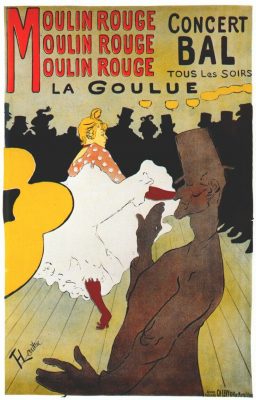
Grimy and dark and electric and stunning, the Museum of Fine Arts’ “Toulouse-Lautrec and the Stars of Paris” presents a wondrous and sly exhibit on artist Henri de Toulouse-Lautrec’s finest work, recreating the feeling of a Parisian era of fame and grit.
The poster craze of the 1800s was in full force by the time Lautrec began his work, with advertisements plastered on every newsstand and building and covering the city in bright swaths of eye-catching promises.
Among these were Lautrec’s advertisements for night clubs, bars and prominent performers, the focus of the MFA exhibition that opened to the public April 7 and remains open until Aug. 4.
Lautrec is by no means an underground artist — his “Moulin Rouge: La Goulue” nightclub advertisement and “Le Chat Noir” cabaret poster are possibly two of the most famous advertisements to date — but the exhibit felt as though it were shining a new light on his entire life, rather than the hits.
Featuring works from friends and those inspired by Lautrec’s work, the exhibit paints a full picture of the era — highlighting works that mirror his own, such as Mary Stevenson Cassatt’s “In the Loge,” which is facing Lautrec’s own “The Box with the Gilded Mask.”
The exhibit mixes in the subtle humor Lautrec was lauded for at the time — the playful way he set the scenes on stage at a club or between friends at a table, through which he was able to imply a wry comment without saying a word. The organization of the paintings holds on to that lightheartedness, which helps to further frame the perceptions of the works.
Although he was very wealthy, Lautrec was most comfortable with those on the fringes, happy to mix with the patrons and performers at Paris’s night clubs and brothels. Due to a genetic disorder that left his bones weak, he broke his legs at a young age and stunted his growth, leaving him at about 5 feet 1 inch tall.
He was most comfortable with perceived misfits, as he perceived himself.
A room of the exhibit is dedicated to his series, “Elles,” which portrays the women of a brothel. The works focus on the daily actions of the women, and the women are drawn with a grace and dignity that shows the artist’s kindness toward a profession that may not have been afforded such niceties at the time.
Lautrec’s bold colors and graphic style bring a whimsical feeling to each piece, giving his art a lightness that perhaps it wouldn’t have otherwise. A prostitute talking to a gentleman at a bar seems less downtrodden than the stereotypes surrounding her profession would suggest.
The enduring quality of Lautrec’s pieces is in his portrayal of everyday life, rarely posed, just glimpses at the movement of the city he admired. He’s pulling the audience in with the looks on the patrons’ faces that invite questions, leaving the audience to lean in and speculate.
Structured in a way that shows his personal growth and explosion onto the scene, the exhibit, split into different sections, builds like a crescendo — ending in the show business world he lauded and was lauded for.
The lighting and color palettes of the space change to reflect the energy of the world Lautrec himself was exhibiting, reflecting his momentum and ability to set the world’s stage.
The music intertwined not only in the subject but in the planned performances and showcases of the artists Lautrec worked with gives another immersive layer, just pushing the audience into that hazy nightclub mindset of cabaret chairs and half-empty bottles and electricity.
Though his life was shortened by a genetic disorder and alcoholism, Lautrec produced more than 700 paintings and 5,000 drawings and firmly established himself as a central printmaker of the 19th century. Looking at just small fraction of his manic 36 years on the planet filled with a flurry of art and expression, it’s easy to see why.















Thank you – this looks like a great exhibit! One correction: The Le Chat Noir posters were actually created by Toulouse-Lautrec’s contemporary, Theophile Steinlen (I’ve just completed writing a children’s picture book biography of Monsieur Steinlen titled The Artist Who Loved Cats!)